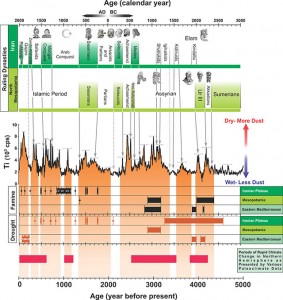New research this week has explored the impacts of abrupt changes in climate on civilizations in the Middle East as well as on the decline and extinction of mammoths. Abrupt climate change is a rapid alteration in the climate, often from wet to dry conditions or vice versa, that happens quickly over a few years or decades rather than over a longer time period. Rapid changes in climate are difficult to adapt to because the time over which the change occurs is so fast.
The Rosenstiel School at the University of Miami issued a press release about a new study to be released in Quaternary Science Reviews which examined peat records for periods of high dust deposition which are believed to correspond to rapid drying in the region.
“The high-resolution nature of this record afforded us the rare opportunity to examine the influence of abrupt climate change on early human societies. We see that transitions in several major civilizations across this region, as evidenced by the available historical and archeological records, coincided with episodes of high atmospheric dust; higher fluxes of dust are attributed to drier conditions across the region over the last 5,000 years,” said Arash Sharifi, Ph.D. candidate at the department of marine geosciences and the lead author of the study.
A separate study published this week in Science and reported in many publications linked the mass extinction of mammoths and other large mammals at the end of the Ice Age to abrupt warming of the climate. A quote from Science News says:
Using advances in analysing ancient DNA, radiocarbon dating and other geologic records an international team led by researchers from the University of Adelaide and the University of New South Wales (Australia) have revealed that short, rapid warming events, known as interstadials, recorded during the last ice age or Pleistocene (60,000-12,000 years ago) coincided with major extinction events even before the appearance of man.
Published today in Science, the researchers say by contrast, extreme cold periods, such as the last glacial maximum, do not appear to correspond with these extinctions.”
